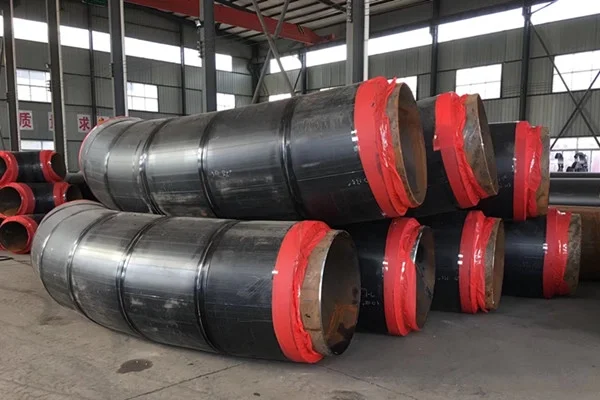Structure and advantages of Insulated thermal insulation steel pipes
Today there is an introduction to some knowledge of Insulated thermal insulation steel pipes, mainly about the structure of Insulated thermal insulation steel pipes and its advantageous features.
In the medium and small diameter of the heat transfer crude oil or heating pipeline, in order to reduce the heat loss from the pipeline to the soil, the insulation composite layer is added to the outside of the pipeline. Commonly used insulation material is rigid polyurethane foam, the applicable temperature is -185 ~ 120 ℃. This material is loose, and in order to improve its strength, a high-density polyethylene layer is added outside the insulation layer to form a composite structure to prevent groundwater from penetrating into the insulation layer. Using high-pressure complete set of polyurethane foaming equipment, the outer surface of the steel pipe is treated with shot blasting and rust removal and the inner surface of the outer sheath pipe is treated with corona process to improve the bonding performance of the insulation pipe. The material of insulation layer is rigid polyurethane foam with density of 60kg/m3 to 80kg/m3, which fully fills the gap between steel pipe and casing and has certain adhesive strength, so that a solid whole is formed between steel pipe, jacket pipe and insulation layer. Polyurethane foam has good mechanical and adiabatic properties and can withstand 120℃ under normal circumstances, and 180℃ through modification or combination with other heat insulation materials.
Structure of Insulated thermal insulation steel pipes
The first layer: working steel pipe layer
Seamless steel pipe, spiral steel pipe and straight seam steel pipe are generally used according to the design and customer's requirements. The surface of steel pipe is treated by advanced shot blasting and rust removal process, and the rust removal grade of steel pipe can reach Sa2 grade in GB/T8923-1988 standard, and the surface roughness can reach R=12.5 microns in GB6060.5-88 standard.
Second layer: polyurethane insulation layer.
Using high-pressure foaming machine in the cavity formed between the steel pipe and the outer sheath at one time to inject rigid polyurethane foam liquid, commonly known as "pipe in pipe foam".
The third layer: high-density polyethylene protective layer.
Prefabricated into a certain wall thickness of black or yellow polyethylene plastic pipe. Polyethylene odorless, non-toxic, feel like wax, has excellent low temperature resistance, the lowest use temperature can reach -70 ~ -100 ℃, good chemical stability, can resist the erosion of most acids and bases (not resistant to acids with oxidizing properties), insoluble in general solvents at room temperature, water absorption is small, but because of its linear molecules can be slowly dissolved in some organic solvents, and does not occur swelling, excellent electrical insulation properties. Its role is to protect the polyurethane insulation layer from mechanical hard object damage, the second is anti-corrosion, waterproof. High-density polyethylene polyurethane foam insulation steel pipe implementation: SY/T114-2000 and SY/T115-2001 standard.

Advantages of Insulated thermal insulation steel pipes features
1. Reduce the project cost
According to the relevant departments, generally speaking, Insulated thermal insulation steel pipes can reduce the project cost of 25% (using glass fiber reinforced plastic as a protective layer) and 10% (using high-density polyethylene as a protective layer) or so.
2. Low heat loss and energy saving
Polyurethane thermal conductivity is: λ=0.013-0.03kcal/m-h-oC, much lower than other commonly used pipeline insulation materials in the past, and the insulation effect is improved by 4~9 times. Then its water absorption rate is very low, about 0.2kg/m2. the reason of low water absorption rate is due to the closed pore rate of polyurethane foam up to about 92%. The low thermal conductivity and low water absorption rate, together with the heat insulation layer and the high-density polyethylene or glass fiber reinforced plastic protective shell with good waterproof performance outside, have changed the condition of traditional trench laid heating pipes "wearing wet cotton jacket" and greatly reduced the overall heat loss of heating pipes, the heat loss of heat network is 2%, far less than the international standard requirement of 10%.
3. Anti-corrosion, good insulation performance, long service life
As the polyurethane rigid foam insulation layer is closely bonded to the outer skin of the steel pipe, it isolates the infiltration of air and water and can play a good role in anti-corrosion. At the same time, its foaming holes are closed, and the water absorption is very small. High-density polyethylene shell, glass fiber reinforced plastic shell have good anti-corrosion, insulation and mechanical properties. Therefore, it is difficult for the outer skin of working steel pipe to be eroded by outside air and water. As long as the internal water quality of the pipeline is treated well, according to foreign information, the service life can be more than 50 years, which is 3~4 times higher than the traditional trench laying and overhead laying service life.
Cangzhou Shenlong Pipe Manufacturing Co., Ltd.is an enterprise specializing in the production, processing and sales of various steel pipes and pipe fittings, with production base in Cangzhou, Hebei Province. It was built in 1992, covering an area of more than 60,000 square meters, with more than 200 employees (including 30 inspectors) and an annual production capacity of about 150,000 tons of steel pipes and 40,000 tons of pipe fittings. We insist on the business tenet of "winning with quality and sincerity" and are determined to create a better future for our international customers with high quality products, reasonable price and good service.
If you still have any questions, please feel free to contact us. We look forward to your cooperation.






